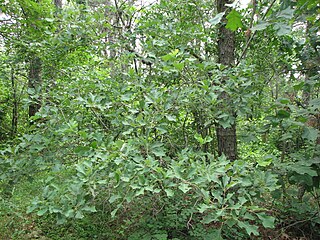
Vaccinium is a common and widespread genus of shrubs or dwarf shrubs in the heath family (Ericaceae). The fruits of many species are eaten by humans and some are of commercial importance, including the cranberry, blueberry, bilberry (whortleberry), lingonberry (cowberry), and huckleberry. Like many other ericaceous plants, they are generally restricted to acidic soils.

Xerophyllum asphodeloides is a North American species of flowering plants in the Melanthiaceae known by the common names turkey beard, eastern turkeybeard, beartongue, grass-leaved helonias, and mountain asphodel. It is native to the eastern United States, where it occurs in the southern Appalachian Mountains from Virginia to Alabama, and also in the Pine Barrens of New Jersey.

Gaylussacia is a genus of about fifty species of flowering plants in the family Ericaceae, native to the Americas, where they occur in eastern North America and in South America in the Andes and the mountains of southeastern Brazil. Common English names include huckleberry and "dangleberry".

The Appalachian mixed mesophytic forests is an ecoregion of the temperate broadleaf and mixed forests biome, as defined by the World Wildlife Fund. It consists of mesophytic plants west of the Appalachian Mountains in the Southeastern United States.

The North Carolina Arboretum is an arboretum and botanical garden located within the Bent Creek Experimental Forest of the Pisgah National Forest at 100 Frederick Law Olmsted Way, southwest of Asheville, North Carolina near the Blue Ridge Parkway. It is open daily except for Christmas Day. There is no admission charge, but some parking fees do apply.

Trillium flexipes, known as the nodding wakerobin, bent trillium, or drooping trillium, is a species of flowering plant in the family Melanthiaceae. It is found from Minnesota to Ohio, south to Tennessee, with isolated populations in New York, Pennsylvania, Alabama, and other states. It is an endangered species in Ontario and possibly extirpated in North Carolina.

In the Appalachian Mountains of the eastern United States, balds are mountain summits or crests covered primarily by thick vegetation of native grasses or shrubs occurring in areas where heavy forest growth would be expected.
Hoverter and Sholl Box Huckleberry Natural Area is a 10-acre (4.0 ha) natural area in Perry County, Pennsylvania, near New Bloomfield, which protects a colony of box huckleberry over 1,000 years old. The smallest Natural Area in Pennsylvania, it is administered as part of Tuscarora State Forest. It was designated a National Natural Landmark in April 1967.

Gaylussacia brachycera, commonly known as box huckleberry or box-leaved whortleberry, is a low North American shrub related to the blueberry and the other huckleberries. It is native to the east-central United States.

Quercus ilicifolia, commonly known as bear oak or scrub oak, is a small shrubby oak native to the Eastern United States and, less commonly, in southeastern Canada. Its range in the United States extends from Maine to North Carolina, with reports of a few populations north of the international frontier in Ontario. The name ilicifolia means "holly-leaved."

Gaylussacia baccata, the black huckleberry, is a common huckleberry found throughout a wide area of eastern North America.

American ginseng is a species of flowering plant in the ivy family Araliaceae. It is native to eastern North America and introduced in China. The specific epithet quinquefolius means "five-leaved", which refers to the typical number of leaflets per leaf. It is one of a group of taxa known as "ginseng".

Clintonia umbellulata, commonly known as white clintonia or speckled wood-lily, is a species of flowering plant in the lily family Liliaceae. The specific epithet umbellulata means "umbelled," which refers to the shape of the plant’s inflorescence.

Arundinaria gigantea is a species of bamboo known as giant cane, river cane, and giant river cane. It is endemic to the south-central and southeastern United States as far west as Oklahoma and Texas and as far north as New York. Giant river cane was economically and culturally important to indigenous people, with uses including as a vegetable and materials for construction and craft production. Arundinaria gigantea and other species of Arundinaria once grew in large colonies called canebrakes covering thousands of acres in the southeastern United States, but today these canebrakes are considered endangered ecosystems.

Gaylussacia dumosa is a species of flowering plant in the heath family known by the common names dwarf huckleberry, bush huckleberry, and gopherberry. It is native to eastern North America from Newfoundland to Louisiana and Florida. It occurs along the coastal plain and in the mountains.

Gaylussacia frondosa is a species of flowering plant in the heath family known by the common names dangleberry and blue huckleberry. It is native to the eastern United States, where it occurs from New Hampshire to South Carolina.

Polemonium vanbruntiae is a species of flowering plant in the phlox family Polemoniaceae. It is known by the common names Appalachian Jacob's ladder, bog Jacob's-ladder, and Vanbrunt's polemonium. It is native to eastern Canada and the northeastern United States.

Gaylussacia nana, the dwarf dangleberry or Confederate huckleberry, is a plant species native to the coastal plains of the southeastern United States. It has been reported from Louisiana, Alabama, Mississippi, Georgia, Florida, North Carolina and South Carolina. It is found in either wet or dry soil, in woodlands, bogs, sandy ridges and savannahs, usually at elevations less than 100 m.

Symphyotrichum oolentangiense, commonly known as skyblue aster and azure aster, is a species of flowering plant in the family Asteraceae native to eastern North America.

Gaylussacia bigeloviana, also known as the northern dwarf huckleberry or in French as the gaylussaquier de Bigelow, is a plant species native to the coastal plains of eastern Canada and the eastern United States. It grows from Newfoundland to South Carolina in swamps and marshes, including acidic bogs alongside Sphagnum peatmosses.



















